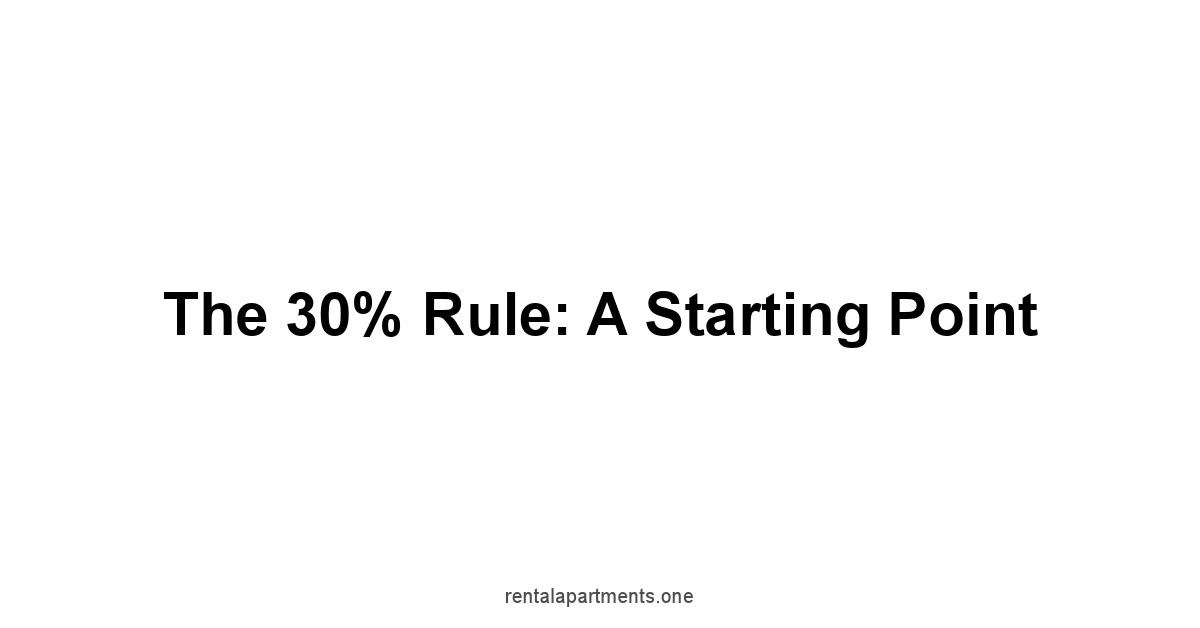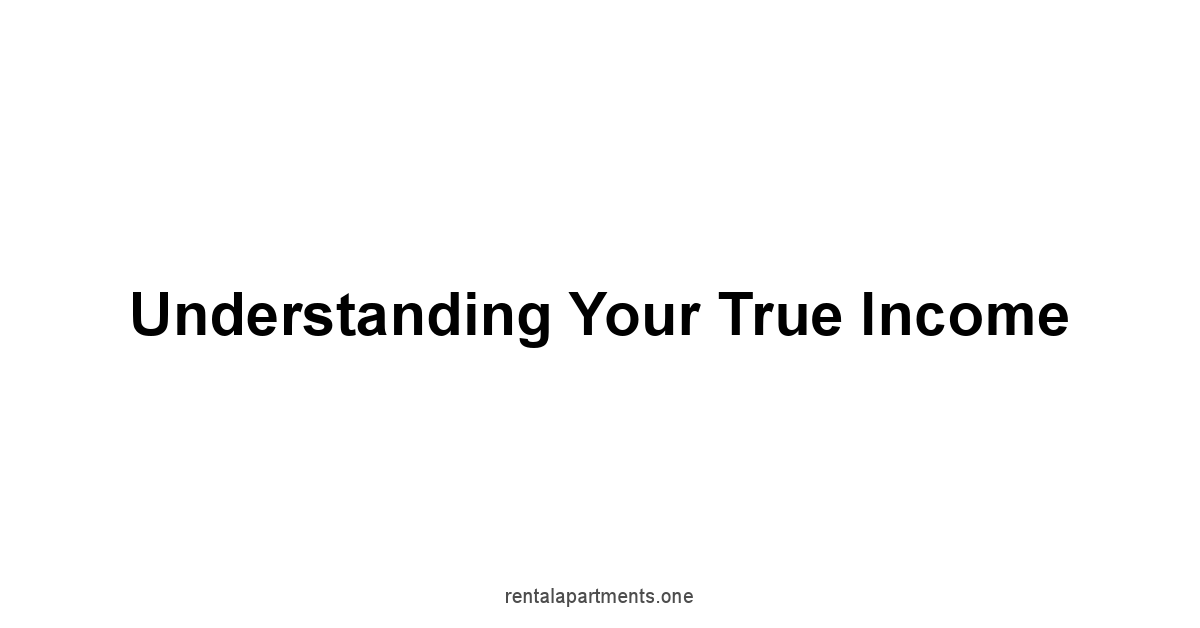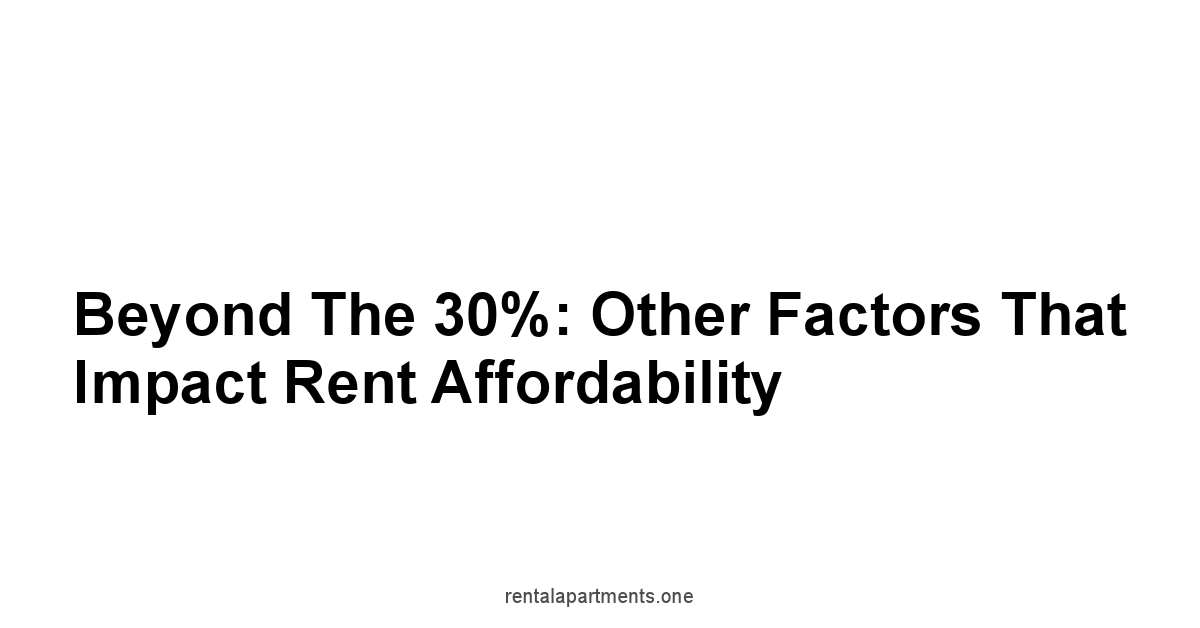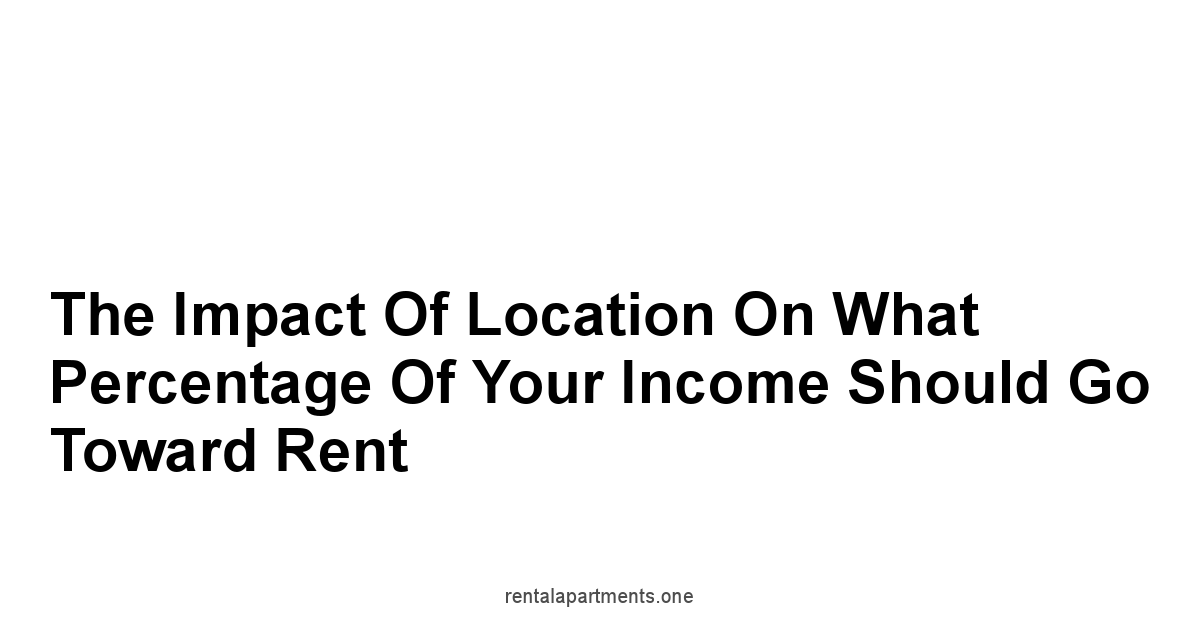The question of what percentage of your income should go toward rent is a question many people face, and while the 30% rule is often cited, it’s like a worn map in a new city—familiar but not always accurate, it’s a starting point, not a destination. This 30% guideline, used by the U.S.
Department of Housing and Urban Development HUD, was meant to keep people from becoming “house poor,” and was born in a time when expenses were simpler, a rule from a different era, and while it’s easy to understand, it might not fit your current situation.
For example, according to the Bureau of Labor Statistics, housing costs have risen faster than wages in many areas of the country, this means blindly following the 30% rule could leave you struggling, and if you’re in a city like San Francisco or New York City the rent will be much higher than say, a rural area in the Midwest, a uniform rule simply doesn’t work for everyone.
Think of it this way, if you’re making a modest income, 30% may not even cover basic housing, and those with high incomes might find it leaves them with too much leftover money and they could easily afford a larger percentage.
It’s essential to go beyond this simple number, and it’s not about disregarding the old rule, it’s about knowing when it’s a good starting point and when it’s not.
The 30% rule can be useful for those with stable incomes, average living costs and low debt but if you have student loans, medical bills, or any other financial commitments, that 30% rule might leave you stretched thin, also it doesn’t account for different lifestyles and what people value.
It’s about being honest with yourself, and assessing all your financial aspects before deciding how much you should spend on rent. Consider these points:
- Net Income vs Gross: You need to know your real number, the money that hits your account. Not the gross salary but the net income, the number left after taxes and deductions.
- Taxes: Federal, state, social security, medicare and any others.
- Deductions: health insurance, retirement contributions, and other things.
- Irregular Income: Freelance gigs, bonuses, commissions can help, but should not be included in your baseline budget, and should be put into savings instead.
There are more factors to consider, beyond just the percentage of your income. Rent is just one piece of a larger puzzle. Think about these expenses:
| Expense Category | Examples |
|---|---|
| Fixed Monthly | Loan payments, Insurance, Subscriptions, phone, internet, childcare |
| Variable Utilities | Electricity, gas, water, trash, recycling |
| Transportation | Car costs, public transport, bike maintenance |
| Food | Groceries, restaurants, takeout |
These are things that you have to pay for every month, and they play a big role in how much you can really afford for rent. Also, consider all of these:
- Move-in fees,
- Home furnishings,
- Maintenance and repairs,
- Renter’s insurance.
The city you choose will also affect how much of your income goes to rent, as shown in the table below.
| Location | Rent Costs | Living Costs | Transportation |
|---|---|---|---|
| Big City | High | High | Often Public |
| Suburbs/Rural | Low | Low | Often Private |
The neighborhood you pick, the amenities, and the demand also play a big part.
A popular neighborhood with lots of shops and parks will come with a higher rent, so you have to find the right balance for yourself.
If you start having a hard time, and your rent takes up more than 30% of your income, you’ll start to notice a few warning signs.
- You are living paycheck to paycheck.
- You’re struggling to pay other bills.
- You’re using credit cards for basic expenses.
- You’re unable to save any money.
These are not things that can be ignored, they can negatively impact your financial future, your ability to build an emergency fund, and you’ll start to feel more stress.
It is not just about a number, it’s about making sure your finances work for you, that you are not struggling, and that you can live comfortably.
The 30% Rule: A Starting Point

The idea of spending 30% of your income on rent—it’s a simple rule, something you hear a lot.
It’s like a comfortable pair of boots, easy to slip into, but are they always the right fit? It’s a guideline, sure, but life, well, it’s rarely that simple.
This 30% figure, it’s not pulled from thin air.
It’s an old idea, designed to help people avoid getting stretched too thin. But what works for one might not work for another.
So, before you start measuring your rent against that number, let’s dig in and see if this old rule still holds water in today’s world.
We need to look closer, see the cracks in the foundation, and decide if it makes sense for you, right where you are, right now.
The Origin of the 30% Guideline
This 30% rule, it’s not new.
It’s been around a long time, back when things were different.
Back when living costs weren’t as varied and complicated as they are now.
Think of it as a rule from a different era, something meant to keep folks from overspending on housing.
The U.S.
Government began promoting this guideline in the 1960s, when they created the National Housing Act.
It wasn’t just a random number, it was meant to give people a simple benchmark.
It was designed to ensure housing costs didn’t swallow up too much of your pay.
The logic was, if you kept your rent to about 30% of your income, you’d have enough left over for other things, for food, for clothes, and even for a bit of fun.
This idea of not being “house poor” started here, and it has stuck around ever since.
- Government Backing: The U.S. Department of Housing and Urban Development HUD has long used the 30% rule as a benchmark for housing affordability.
- Simplicity: It’s an easy-to-understand concept, making it accessible to the average person.
- Historical Context: The rule was established during a time when living expenses were generally more predictable and consistent across the country.
- Widespread Adoption: Due to its simplicity and government backing, many lenders and financial advisors have adopted and promoted the 30% rule.
Why the 30% Rule Can Be Too Simple
This 30% rule, it’s easy to remember, but life isn’t always that clean cut.
It doesn’t take into account that some folks make more than others and some cities cost more than others.
Some people have a lot of debt, and some people have very little.
The 30% rule works for some, but it doesn’t fit everyone.
The world’s changed, and it keeps changing.
Living costs have risen, wages haven’t kept pace, and debts have piled up. The 30% rule was born in a different world.
Now, depending on where you are, you might find yourself in a place that’s way more expensive than it used to be.
So, you can’t blindly follow a rule that doesn’t consider the realities of your situation, that doesn’t consider the full picture of the life you’re trying to live.
- Cost of Living Variation: The cost of living differs significantly between cities and towns, rendering a uniform 30% rule ineffective. For example, rent in New York City will be much higher than rent in a rural area in the Midwest.
- Individual Financial Situations: Personal circumstances such as debt, student loans, medical expenses, and other financial commitments aren’t considered by the 30% rule.
- Income Levels: Those earning lower incomes may find that even 30% of their income doesn’t cover a basic standard of living, whereas those with higher incomes may have more room to allocate towards housing.
- Lifestyle Choices: Your lifestyle and what you value, what you need in your day-to-day, this can impact whether the 30% rule is appropriate.
When the 30% Rule Makes Sense
Still, this 30% rule, it isn’t all bad.
There are times when it’s actually a pretty good place to start.
For someone just starting out, or in a place where costs are pretty steady, it can provide a clear and simple benchmark.
If you’re living in an area where the cost of living is average, where rent isn’t too high, and your financial life is fairly straightforward, the 30% rule can be a useful tool. It helps keep your housing costs in check.
It helps you avoid stretching your budget so thin that a single unexpected bill throws you off course.
But remember, it’s a starting point, not a final answer.
You still need to look at your specific situation and adjust to fit your life, to make sure it’s not squeezing you too tight.
- Stable Income and Expenses: When your income and expenses are predictable, the 30% rule can offer a good baseline.
- Average Cost of Living Areas: In cities or towns where housing costs aren’t extremely high, this rule is more applicable.
- Young Professionals: For those just starting out, the rule can be a practical way to manage housing costs.
- Financial Stability: If you have low debt, good savings, and a stable job, the 30% rule can be a good reference point.
Understanding Your True Income

Before you can even think about percentages, you’ve got to understand what you really make, what the real number is after they take their cut.
It’s not just the number on your paycheck that matters, the gross number.
You’ve got to dig deeper, look closer at what actually goes into your pocket.
The difference between the big number you see at first glance and the real number that hits your bank account, well, that’s what will make or break your budget.
It’s not just your salary.
Your true income isn’t the number your boss tells you, it’s the number you have when it’s all said and done.
Taxes, deductions, and everything else that nibbles away at your paycheck all add up.
Knowing this is key to building a budget that works for you, not against you.
It’s about being honest with yourself and not playing pretend about what money you actually have to work with.
Gross Income vs. Net Income for Rent Calculations
Gross income, that’s the big number they throw at you, before anyone takes their share.
Net income, that’s what’s left when they’re done with you, the money that you can actually spend.
When you’re thinking about your rent, you need to be looking at that smaller number, the real number, not the one that feels good to hear.
Figuring out your net income is the foundation of a good budget.
You can’t base your rent on some big number you don’t even touch.
You have to be realistic, practical, you have to see where the real number is, the one you can use for rent and food and all your other expenses.
It keeps you grounded, makes sure you are not living outside your real budget.
- Gross Income:
- This is your total pay before taxes and deductions.
- It’s usually the number stated in your job offer or salary agreement.
- It provides a general overview of earnings but not actual spending power.
- Net Income:
- This is your take-home pay after all taxes and deductions are subtracted.
- It’s the money you actually have available for rent, groceries, and other expenses.
- Essential for creating an accurate and realistic budget.
- Why Net Income Matters:
- Using net income prevents you from overestimating your available funds.
- It helps you avoid getting rent-burdened because you are working with the correct number.
- It enables more accurate budgeting and financial planning.
- Example: If your gross income is $5,000 per month and your taxes and deductions are $1,500, your net income is $3,500. This $3,500 is what you should use for rent calculations.
Accounting for Taxes and Deductions
Taxes, they’re a fact of life, something we all have to deal with.
They’re also the biggest chunk of your paycheck that disappears before you even get to see it.
Then come deductions – health insurance, retirement contributions, all these things that take a bite out of your gross.
You can’t ignore these if you’re serious about budgeting.
Taxes and deductions, they are all different depending on where you are, what you do and your own personal situation.
Knowing all of these details allows you to create a budget that works for you, one that takes into account your own unique situation.
Ignoring them is like pretending they’re not there, and that’s a dangerous game to play with your money.
- Federal Income Tax: This is a percentage of your income that goes to the federal government.
- State Income Tax: Many states also have their own income tax rates.
- Social Security and Medicare: These are payroll taxes that fund social security and Medicare programs.
- Health Insurance Premiums: If you receive insurance through your employer, a portion of your paycheck will go toward your premiums.
- Retirement Contributions: Money you contribute to a 401k or other retirement plan is deducted from your paycheck.
- Other Deductions: These can include life insurance premiums, HSA contributions, and other employee benefits.
- Importance: Understanding these deductions helps you accurately calculate your net income.
- How to Calculate:
- Review your pay stub carefully.
- Use online tax calculators to estimate your tax obligations.
- Consult a financial advisor or accountant for personalized advice.
Factoring in Irregular Income Sources
Not everyone has a steady paycheck that comes like clockwork.
Some of us have side jobs, freelance gigs, or seasonal work.
This irregular income, it’s money that can help, but it’s not always reliable.
You need to figure out how to factor it in without counting on it too much, without letting it trick you into thinking you’re richer than you are.
Irregular income can be tricky. Sometimes it’s there, sometimes it’s not.
It’s good to have a plan for it, a way to make it work for you without disrupting your budget.
Don’t factor it into your baseline rent calculations.
Instead, if the money is there, put it in your savings or use it for something extra, use it to get ahead, not to stay afloat.
- Types of Irregular Income:
- Freelance work
- Part-time jobs
- Bonuses
- Commissions
- Overtime pay
- Gifts
- Seasonal work
- Challenges:
- Difficult to predict the exact amount and timing of the income.
- Can lead to overspending if counted as guaranteed money.
- Strategies for Managing Irregular Income:
- Average It Out: Calculate your average irregular income over the past few months and use this as a conservative estimate in your budget.
- Set It Aside: Put extra income into a savings account or an emergency fund instead of spending it immediately.
- Use It for Goals: Use extra income to pay down debt or save for a specific financial goal.
- Create a Buffer: Have a buffer in your budget to account for months when irregular income is lower than expected.

Why Ignoring “Extra” Money Is Important for Your Budget
That extra money, the little bit you get from a bonus, or a side job, it’s tempting to think of it as free money.
But if you start including it in your rent calculations, it can mess you up.
It can make you feel safe when you’re not, and it can lead you to living in a place you can’t actually afford.
It’s important to see extra money for what it is, a bonus, not something you can rely on each month.
This way, your base budget will be solid, built on the income you know you can count on.
This will let you save a little more, pay down debts and put your extra money to good use, instead of having to just make ends meet.
- Budget Stability:
- Relying on “extra” income makes your budget unstable.
- It can lead to overspending during high-income periods and struggles during lean months.
- Avoid Overspending:
- Treating extra income as guaranteed can lead to a lifestyle that is difficult to maintain.
- It can make you take on financial obligations you can’t consistently meet.
- Financial Security:
- Saving extra income creates an emergency fund and financial security.
- It helps you achieve long-term financial goals like paying down debt and investing.
- Realistic Budgeting:
- Using only your reliable, consistent income for budgeting keeps your spending habits in check.
- It makes it easier to identify when and where to make adjustments.
- Mindset Shift:
- See extra income as a bonus that can improve your financial situation.
- It allows you to plan for the future instead of just meeting immediate needs.
Beyond the 30%: Other Factors That Impact Rent Affordability

The 30% rule, it’s a guide, but it’s not the whole story.
There are other things that play a big part in how much you can really afford in rent.
It’s not just about the number, it’s about everything else you have to pay for.
You need to look beyond the rent itself, see the whole picture, every expense that comes with living life.
Rent isn’t the only thing you have to pay for, there are other regular expenses, things you have to pay for every month, those have to be accounted for.
It is not just about finding a place where the rent is “affordable”, it’s about making sure you have the money to pay for all the other parts of your life, all the other things you need.
You need to consider all the hidden costs, the things that are not on the surface, things that can eat up your income quickly.
Your Fixed Monthly Expenses Beyond Rent
Rent is just one piece of the puzzle.
There are other bills, some that don’t change each month, that are always there, and you have to account for all of them.
These fixed expenses, like car payments, student loans, and insurance, they eat up a big part of your income every month.
You need to know how much is going out every month before you can figure out what you can afford for rent.
These bills, they are as regular as the sunrise, they come no matter what.
Ignoring them is a mistake that many people make, but you can’t afford to.
Every bill is taking a piece of your financial pie, and it’s your job to know exactly where each piece is going.
Once you see all of these bills laid out in front of you, you’ll have a clearer view of how much you have for rent, the real number, not just a guess.
- Loan Payments:
- Car loans
- Student loans
- Personal loans
- Insurance Premiums:
- Car insurance
- Health insurance
- Renter’s insurance
- Life insurance
- Recurring Subscriptions:
- Streaming services
- Gym memberships
- Software subscriptions
- Other Fixed Expenses:
- Childcare costs
- Alimony or child support payments
- Phone bill
- Internet bill
- Importance:
- These expenses don’t change month to month.
- They need to be paid, regardless of income.
- Calculating Fixed Expenses:
- List all of your fixed expenses.
- Calculate the total cost of these expenses every month.
- Subtract the total of your fixed expenses from your net income to understand what you have left for rent.
The Cost of Utilities That Can Vary by the Season
Utilities, they’re something you can’t escape.
They keep the lights on, keep you warm, and keep you cool.
But they are also expenses that aren’t fixed, they can change with the weather, and it is hard to predict from month to month.
This makes them a tricky part of the budget, and you need to be aware of what they can do to your finances.
These utility bills, they can fluctuate depending on the time of year, they are not the same in the middle of summer as they are in the middle of winter.
It’s important to have a sense of what to expect from month to month and be ready for the changes that may come.
Not all months are equal and you need to factor these costs in when planning your finances.
- Electricity: Costs can increase during summer due to air conditioning and during winter with space heaters.
- Natural Gas: Used for heating in the winter, costs will rise in cold months.
- Water: Usage can vary depending on season, outdoor watering, and other factors.
- Trash and Recycling: Often a fixed monthly cost but can vary based on your area.
- Internet and Cable: While the bill itself may be fixed, the quality and speed affect the overall value.
- Seasonal Variability:
- Summer: Higher air conditioning costs
- Winter: Higher heating costs
- Spring/Fall: Typically moderate usage but can vary widely
- Managing Utility Costs:
- Budgeting: Estimate your monthly utility costs based on past bills and the season.
- Conservation: Use energy-efficient appliances, turn off lights when not in use, and adjust the thermostat.
- Research: Compare utility providers to find the best rates for your area.
- Insulation: Proper insulation can reduce your heating and cooling costs.
- Payment Plans: Some providers offer budget billing, which averages out your utility costs over the year.
Commuting Costs and Their Affect on Your Budget
Getting to work, that’s another cost you can’t forget.
Whether you’re driving, taking the train, or riding your bike, it all costs money.
It’s important to add this into your monthly budget, to see how much your commute is eating into your money.
It can be a bigger bite than you think and you have to know how much it costs to get to work and back.
The price of gas, the cost of public transportation, or the wear and tear on your bike, it all adds up. It’s money out of your pocket every month.
When deciding on rent, you have to think about these costs, the impact your commute will have on your financial situation, and what you can afford in the long run.
- Transportation Expenses:
- Car: Gas, maintenance, repairs, insurance, and parking fees.
- Public Transportation: Bus, train, subway, or ferry fares.
- Biking: Maintenance costs, equipment, and safety gear.
- Walking: Requires appropriate shoes and gear for different conditions.
- Time Costs:
- Time spent commuting can be a factor in calculating your total commuting costs.
- Long commutes can reduce free time and increase stress.
- Hidden Commuting Costs:
- Wear and tear on your vehicle or bike.
- Lost time that could be used for work, leisure, or rest.
- Calculating Commuting Costs:
- Car: Calculate the cost per mile of driving, including gas, maintenance, and insurance.
- Public Transportation: Determine the cost per trip or the monthly pass fee.
- Biking: Track maintenance costs and other expenses.
- Impact on Budget:
- Consider the trade-off between housing costs and commuting costs.
- If a lower rent means a longer commute, you have to decide what is more important to you.
Food Expenses Need to Be Taken Into Account
You have to eat, and that costs money too.
Food is a big part of your budget, and you need to account for it when you are figuring out how much you can pay for rent.
It’s easy to underestimate how much you spend on food if you’re not keeping track.
So, you need to have a good idea of what you’re spending on groceries, going out, or ordering in.
Food is a necessity, and the amount you spend on food will impact how much you can afford for rent.
Eating out, grabbing a quick bite, or buying pre-made meals, it all adds up quickly.
If you’re not aware of where your money is going you will never know how much you can really spend on rent.
- Groceries:
- The cost of food from the grocery store or farmer’s market.
- Can vary based on your meal plans and dietary needs.
- Eating Out:
- The cost of dining at restaurants, fast food places, or coffee shops.
- Often a significant expense for those who don’t cook at home.
- Takeout/Delivery:
- The cost of food delivered to your home.
- Usually more expensive due to delivery fees and tips.
- Hidden Food Costs:
- Food waste can significantly increase your overall food spending.
- Impulse purchases at the grocery store can add to your bills.
- Coffee, snacks and drinks bought during the workday add up.
- Strategies for Managing Food Costs:
- Plan Your Meals: Create a weekly meal plan and make a shopping list.
- Cook at Home: Eating at home is generally cheaper than eating out.
- Reduce Food Waste: Use leftovers and store food properly.
- Budget: Set a weekly or monthly budget for food expenses.
- Shop Smart: Compare prices and look for deals.
The Hidden Costs of Housing That Many People Forget About
There are hidden costs that come with renting, the things that aren’t always obvious when you’re signing a lease.
These costs can add up, and if you don’t plan for them, they can hurt your budget.
It’s not just about the rent, it’s about all the extra expenses that go along with having a home.
You have to know all of these extra expenses so you don’t get blindsided.
These hidden costs, they’re the sneaky ones. They’re the ones that can catch you by surprise.
But if you’re aware of them, if you know what they are, you can be ready for them.
You need to know what could be coming your way so you can plan accordingly and avoid any surprises.
- Move-in Fees:
- Security deposit
- First month’s rent
- Application fees
- Moving costs
- Home Furnishings:
- Furniture, decor, kitchen supplies, bedding
- Can be a significant cost if you are starting from scratch.
- Maintenance and Repairs:
- Minor repairs that may not be covered by the landlord.
- Replacement of damaged items.
- Renter’s Insurance:
- Protection of your belongings from damage or theft.
- Often required by landlords.
- Parking Fees:
- If you drive, the cost to park your vehicle.
- This can be an added cost in many cities.
- HOA Fees:
- If your building has a homeowners association you may need to pay extra fees.
- Unexpected Expenses:
- Sudden repair needs.
- Medical expenses.
- Job loss.
- Strategies for Managing Hidden Costs:
- Create an emergency fund for unexpected expenses.
- Shop wisely for furnishings and home supplies.
- Read the lease carefully to understand your responsibilities.
- Get renter’s insurance to protect yourself from the unexpected.
The Impact of Location On What Percentage of Your Income Should Go Toward Rent

Where you live has a huge impact on how much you’ll spend on rent.
A small apartment in one city can cost the same as a big house in another.
The location you choose, it’s not just about the view, it’s about how it fits into your budget.
It’s important to see where the best financial fit is, and what your choices mean for your finances.
Different cities have different costs, and different neighborhoods in the same city have different costs.
The location can change everything about your finances, it can make or break your budget, and can be the difference between feeling comfortable and feeling like you are constantly struggling.
Location, it’s not a small thing, and it can really affect your finances.
The Cost of Living In a Big City
Big cities, they come with a price.
The rent is high, the crowds are big, and everything else seems to cost a little bit more.
There is a lot to love about the city, but it’s important to understand what these high costs mean for your budget, and how much of your income will go to just living there.
The bright lights, the fast pace, the energy of a big city, they all come at a cost.
The convenience of a city, all the things you can do, the ability to walk everywhere, it will all cost you more. You must be ready for this.
You have to be aware of how your rent may be higher, how everything else is higher, so you can make the best choice for yourself.
- High Rent Costs:
- Demand for housing is usually very high in big cities.
- Apartments, even small ones, can be very expensive.
- Competition for rentals drives up prices.
- Higher Cost of Goods and Services:
- Groceries, restaurants, and other goods and services often cost more.
- Increased costs are a result of higher operational costs for businesses.
- Transportation Costs:
- While public transportation is often available, it may still come with significant expenses.
- Parking in big cities can be very expensive.
- Lifestyle and Entertainment:
- Access to cultural events, dining, and nightlife comes with higher costs.
- Activities that might be affordable in smaller cities might be out of reach in a big city.
- Benefits:
- More job opportunities.
- Access to cultural and entertainment options.
- Better public transportation systems.
- Convenience and walkability.
- Managing Big City Costs:
- Consider living in a less central neighborhood.
- Take advantage of free activities.
- Cook at home and pack lunches.
- Use public transportation instead of driving.
Rent Prices in the Suburbs and Rural Areas
The suburbs and rural areas, they offer a different lifestyle, a slower pace, more space, and often lower rent.
If you are looking to save money, these places can often be a lot cheaper than living in the city.
You have to consider what type of life is best for you, and if a move to the suburbs could work better for you financially.
There is an appeal to moving to a more calm place, to having a slower pace, and the suburbs or the country can give you that.
But these places also come with their own set of issues to consider, and before you make the move you have to consider all the angles, the good and the bad, and see if this type of living is right for you.
- Lower Rent Costs:
- Rent is typically lower than in big cities due to lower demand.
- More space for less money is usually available.
- Lower Cost of Goods and Services:
- Groceries and other goods and services are usually more affordable.
- Local businesses often have lower overhead costs than in big cities.
- Car ownership is often necessary because public transport is not as developed.
- Gas prices can vary but can be a significant expense in rural areas.
- Lifestyle:
- A slower, more laid-back pace of life.
- More focus on outdoor activities and community.
- Drawbacks:
- Limited job opportunities compared to big cities.
- Fewer cultural and entertainment options.
- Less access to public transportation.
- Managing Costs:
- Look for areas with good local amenities.
- Budget for car expenses.
- Find local farmer’s markets for affordable produce.
- Participate in community events for entertainment.
Demand Affects Pricing
The basic rule of economics is, if there is demand, prices go up. It applies to everything, including rent.
When lots of people want to live in a certain area, landlords can charge more for rent.
This is why knowing how demand works in different areas is important when you are trying to figure out how much rent you can afford.
High demand areas mean higher rents, it’s the basic rule.
If you want to live in a popular area, you need to be ready to pay the premium.
It’s the price of being in a place where lots of people want to be, and you need to factor this into your budget to avoid any surprises.
Understanding demand will help you be smarter when you look for a place.
- High Demand Areas:
- Popular neighborhoods, city centers, and areas with good amenities tend to have higher rent.
- Landlords can raise prices because of the high demand.
- Competition for rentals is higher, making it difficult to find a good deal.
- Low Demand Areas:
- Less popular neighborhoods, rural areas, or locations with fewer amenities tend to have lower rent.
- There is often less competition for rentals, so you may have an easier time finding a place.
- Landlords may offer incentives to attract tenants.
- Factors That Influence Demand:
- Job opportunities in the area.
- Proximity to public transport.
- Access to amenities like parks, shops, and schools.
- Safety and crime rates in the area.
- How to Spot Demand:
- Check how quickly rental listings are filled.
- Talk to real estate agents to get a sense of market trends.
- Look at the number of vacancies and price changes over time.
- Managing Demand:
- If you are in a high demand area, be ready to pay more for rent.
- Consider moving to a less popular area to save money.
- Be proactive and prepared to act quickly when you find a place you like.
The Impact of Amenities and Neighborhood Appeal on Rent
What the neighborhood has to offer, the parks, the restaurants, the walkability, the stores, all those things they add to the price of rent.
A neighborhood that is desirable, a place people want to be, those are going to cost you more.
You have to balance what you want in a neighborhood with what you can afford to pay for it.
It’s a give and take. The more amenities you want, the more you will pay.
You have to figure out what’s important to you, what you can live without, and what you want to spend your money on.
It is your choice, but it will affect your budget and the place you decide to live.
- Amenities:
- Parks, green spaces, and recreational facilities
- Grocery stores, shops, and restaurants
- Libraries, community centers, and schools
- Fitness centers and gyms
- Neighborhood Appeal:
- Safe and well-lit streets.
- Low crime rates.
- Good schools.
- A vibrant and welcoming community.
- Clean and well-maintained streets.
- How They Affect Rent:
- Areas with lots of amenities and neighborhood appeal are in high demand.
- Higher demand leads to higher rent costs.
- Landlords often charge a premium for living in desirable areas.
- Balancing Amenities and Budget:
- Identify what amenities are most important to you.
- Consider if you can give up a few amenities to save money.
- Look for neighborhoods that are on the rise that may offer a good balance of amenities and prices.
- Smart Choices:
- If you are on a tight budget, you may need to look for an area with fewer amenities or one that is less developed.
- It’s possible to live near amenities without paying the highest prices by looking for alternatives or less popular areas.
What Happens If Your Rent Exceeds 30%?

When your rent takes up more than 30% of your income, things can get tight.
It means you are spending a big part of your money on housing, and that can leave less money for everything else.
Being rent-burdened is not something to take lightly, it can affect your financial stability and your overall well-being.
Living with high rent means less money for savings, for emergencies, and for life.
It can feel like you’re constantly scrambling to make ends meet.
It’s a situation that can add stress and financial hardship.
When rent is too high it can affect every other aspect of your life, it can put you in a tough spot, and it’s important to see the signs before things go wrong.
The Signs of Being Rent-Burdened
Being rent-burdened, it’s not just a feeling, it’s a reality that shows up in your finances and your life.
It’s when rent starts to take up too much of your income, and it affects your ability to pay other bills.
You can tell you’re rent-burdened when you are living paycheck to paycheck, and you are always one emergency away from falling behind.
These signs, they are warnings, they are telling you to take a look at your situation, to see if your finances are in trouble.
Ignoring these signs will not make them go away, they will only get worse.
It’s your job to be honest with yourself and see if your rent is too high.
- Living Paycheck to Paycheck: If you are spending all of your income every month and don’t have any money left over you are likely rent-burdened.
- Difficulty Paying Other Bills: If you are falling behind on other bills, like utilities or credit cards, it’s a sign your rent is too high.
- Using Credit Cards for Basic Expenses: If you rely on credit cards to pay for groceries, gas, or other necessities, you are putting yourself into debt.
- Inability to Save Money: If you cannot save for emergencies, you are living too close to the line.
- Constant Stress: If you’re constantly worrying about money and how to pay bills it’s a sign that things need to change.
- Making Sacrifices: If you are giving up essentials like healthy food, or health care in order to pay rent, things need to be adjusted.
- Delayed Bills: When you are paying bills late consistently it means you are not in a good financial place.
- Seeking Assistance: Relying on emergency funds or government assistance is a sign that your rent is too high.
The Impact of Being Rent-Burdened on Your Savings
When your rent is too high, it’s usually your savings that suffer the most.
It’s hard to put money away for the future when all your money is going to pay for your housing.
You will find it hard to build an emergency fund, or make any long-term plans.
It’s a situation that can hurt you in the long run, and put you in a difficult financial place.
If you can’t save, you’re always one step away from a financial crisis.
It’s not just about not having money in your account, it’s about the stress and insecurity that comes with it.
You are in a difficult spot, and the only way out is to acknowledge the issue and do something about it.
- Lack of Emergency Fund: If you can’t save for unexpected expenses, like car repairs or medical bills, you will be at risk.
- Inability to Save for Retirement: Being unable to put money away for retirement will make your long-term financial security unstable.
- Missed Financial Opportunities: Without savings, you can’t take advantage of investment opportunities or any other opportunities that might come your way.
- Increased Debt: When you don’t have savings, it can make you rely on credit cards or loans when emergencies happen.
- Financial Stress: The constant worry of not having any savings can lead to stress and anxiety.
- Cycle of Debt: Without savings, you can get stuck in a cycle of relying on debt to manage expenses.
- Limited Options: Not having savings limits your ability to make life changes, like moving or changing jobs.
Final Thoughts
The 30% rule, it’s a starting point, nothing more. Life is more complicated than a simple percentage.
The key is to see what your real income is, your net income after all the taxes and the deductions, the money you have to work with.
Then, you have to look at all your other costs, not just rent, the utilities, the commute, the food.
It’s all these things together that make up your true monthly expenses.
It is only by looking at all the costs can you get an accurate picture of what percentage of your income should actually go toward your rent.
According to a recent study from the Bureau of Labor Statistics, housing costs are one of the largest expenses for most Americans, accounting for about 33% of total household spending.
But don’t let this number be your only guide, your life is your own, and you have to make sure the numbers work for you.
Location, it plays a big role.
A place in the city, that comes with a hefty price, while something in the suburbs or rural areas might cost less, but you’ll have to see if that is your style.
You can save money by moving to a place where the demand is not as high, and maybe you will like living there better.
It’s about balancing the costs with the life you want to live.
It’s about figuring out where that balance lies, what fits your finances, your life, and what you value.
Don’t get caught up in the idea of a perfect apartment, find the right fit for you, the one that matches the real numbers in your bank account and your unique needs.
The National Low Income Housing Coalition reports that in some major metropolitan areas, more than 50% of renters are considered cost-burdened, spending over 30% of their income on housing.
If you find yourself paying more than 30% of your income on rent, you need to take a look at things.
Are you living paycheck to paycheck, or are you having trouble paying your bills? Are you dipping into your savings to stay afloat, or using credit cards for the basic necessities? These are signs that your rent is too high.
It’s not about ignoring these things and hoping they will go away, it’s about taking charge, and making smart decisions that will help you now, and in the future.
The goal is to live within your means, not to live at your limit and always worry about how you will make ends meet.
According to a Harvard study, households that spend more than 30% of their income on housing are more likely to face financial hardship, including difficulties paying for other essential expenses like healthcare and food.
The 30% rule, it’s not a law. It’s a guide, nothing more.
The real number for you, it’s about knowing yourself, knowing your own financial situation, the cost of everything in your life, and making the smart choices that will fit your needs. Don’t let a simple percentage dictate your life.
Look at the whole picture, your unique situation, and make the decisions that are right for you, and not what some old rule says.
Live smart, and you will find a home that fits your life, not one that is squeezing you dry.
Frequently Asked Questions
What exactly is the 30% rule for rent?
It’s a guideline that says you should spend no more than 30% of your income on rent.
It’s a simple rule that’s been around for a while, meant to keep you from getting house poor, but it’s not a perfect fit for everyone.
It was a different world when that rule was made, life has changed.
Where did the 30% rule come from?
Government started pushing this idea back in the 1960s.
They wanted people to have a simple way to figure out housing costs, to make sure rent didn’t eat up too much of their pay.
It’s been around a while, it’s a rule from a different time.
Why might the 30% rule not work for me?
The cost of living is different everywhere. Some cities are way more expensive than others.
Your personal finances, your debts, they’re different, too.
The 30% rule is simple, but life, well, it’s not so simple. It’s not a perfect rule for everyone.
When is the 30% rule a good guideline?
If you have steady income, and live in a place where the cost of living is average, it can be a useful guide. It can help you keep your housing costs in check.
It can help you avoid stretching your budget so thin that a single unexpected bill throws you off course. But it’s not a final answer.
What’s the difference between gross and net income, and why does it matter for rent?
Gross income is what they tell you that you are making before taxes and deductions.
Net income is what you actually take home after all the deductions are made.
When figuring out rent, you have to use your net income, that’s the real number that you have to work with. You can’t spend what you don’t actually have.
What kind of taxes and deductions should I be looking for?
Federal income tax, state income tax, social security, Medicare, insurance, retirement contributions, that’s just some of what can be taken out of your paycheck. It’s all different for each person.
You have to know this to get a real picture of what you actually make. It’s not a game of pretend.
How do I handle irregular income when budgeting for rent?
Don’t rely on it.
If you have a side job, or work that is not always steady, don’t count on it for rent.
See it as a bonus, something extra, not something you have to use to make ends meet. Don’t play pretend.
Besides rent, what are other fixed expenses I should consider?
Loan payments, car payments, insurance premiums, subscriptions, they’re all fixed, and they all eat away at your income. These costs don’t change month to month.
They have to be accounted for when figuring out rent.
How do utilities affect my budget?
Utilities, they can change by the season.
Heating in the winter, cooling in the summer, they’re not always the same.
You have to factor in how these things will fluctuate, it’s a part of life.
Why are commuting costs important when looking for a place to rent?
Gas, public transport, it all costs money.
Commuting costs eat into your budget, and you have to account for them.
Don’t forget that the cost of getting to work is also a cost of living, you have to think about everything.
Why should I factor in food expenses when considering rent?
Food is another big part of your budget. You have to eat, and it’s not free.
Eating out, groceries, you need to know where your money is going to see if you can afford the rent.
What are some hidden costs of housing I should be aware of?
Move-in fees, security deposits, application fees, furniture costs, maintenance, and renter’s insurance, these are costs that get you if you don’t look out for them.
You need to plan for them, that’s how you avoid surprises.
How does location affect how much I should spend on rent?
Big cities cost more. Suburbs are sometimes less.
It’s all about supply and demand, the more people that want a place, the more you will pay for it.
You have to think about what you want, and what you can afford.
What happens if my rent is more than 30% of my income?
Things will get tight.
You’ll likely be living paycheck to paycheck, struggling to save, and feeling the constant stress of not having enough. It’s not a good place to be.
What are the signs that I’m rent-burdened?
Living paycheck to paycheck, struggling to pay other bills, putting everything on credit cards, those are all signs you are spending too much on rent. Those are red flags, don’t ignore them.
How does being rent-burdened affect my savings?
When your rent is too high, your savings will suffer.
It will be hard to build an emergency fund, or make any long-term plans.
You need to see the big picture, not just the next month.




